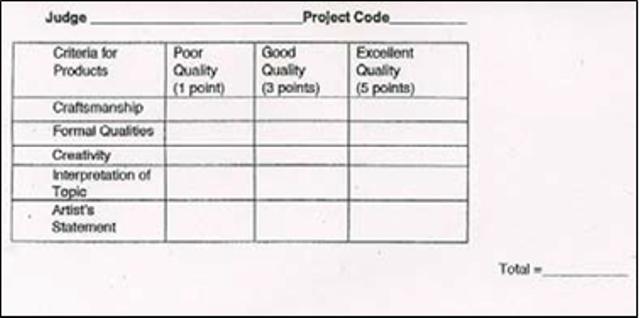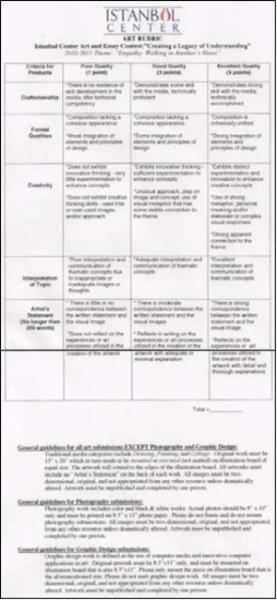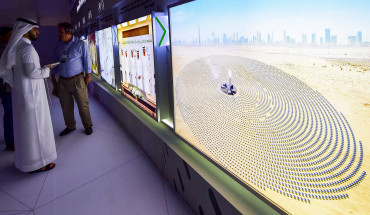Originally posted June 2011
During my senior year coursework in the art education program at Kennesaw State University, I had the unique opportunity to judge the artwork of Georgia middle and high school students at the Istanbul Center in Atlanta. As an advisory board member of the Istanbul Center, Dr. Bird, the professor of my Teaching Art History and Aesthetics course, has built a strong professional friendship with this Turkish non-profit organization. Through this connection, as a class, we were invited to participate in judging the first round for the artworks submitted for the 4th Annual Istanbul Center Art & Essay Contest. The main objective of the Istanbul Center’s art contest is to have students in middle and high schools think about and be involved in solving social problems in our world today, such as intercultural understanding and respect towards others.
 The Istanbul Center Headquarters, located in Midtown Atlanta, was very welcoming and provided an environment that advocates travel to the historic and culturally rich Turkish capital city. The representatives of the Istanbul Center were a wonderful source of information and they were eager to help us feel at home. The staff showed Turkish hospitality by offering delicious, traditional Turkish foods and teas.
The Istanbul Center Headquarters, located in Midtown Atlanta, was very welcoming and provided an environment that advocates travel to the historic and culturally rich Turkish capital city. The representatives of the Istanbul Center were a wonderful source of information and they were eager to help us feel at home. The staff showed Turkish hospitality by offering delicious, traditional Turkish foods and teas.
After arriving at the Istanbul Center, our class was split into numerous small groups, which were determined by our medium of expertise (e.g., photography, drawing and painting, and graphic design). Piles of artwork covered the tables and lined the walls, some still in their original mailers. Only after joining the photography group, did I realize that the vast majority of art applicants were photography students. It was clear that our group had our work cut out for us.  Due to time constraints, my group had to quickly work through our piles of artwork. Our primary goal the first day was to separate the artwork that met the basic criteria of size and included an artist’s statement as established by the Istanbul Center. The second day we were given rubrics to score the artwork. Our rubrics contained a list of the formal criteria of the contest and included craftsmanship, formal qualities, creativity, interpretation of the topic “Who is your Neighbor?” and the artist’s statement.
Due to time constraints, my group had to quickly work through our piles of artwork. Our primary goal the first day was to separate the artwork that met the basic criteria of size and included an artist’s statement as established by the Istanbul Center. The second day we were given rubrics to score the artwork. Our rubrics contained a list of the formal criteria of the contest and included craftsmanship, formal qualities, creativity, interpretation of the topic “Who is your Neighbor?” and the artist’s statement.
As a first-time art judge, I had reservations giving students low scores when they did not meet the requirements of the contest. Unfortunately, a large amount of meaningful artwork was disqualified for failure to  meet the guidelines of the contest. If their teachers better express the parameters of the contest to the students, perhaps this could be avoided in the future. The most frequent discrepancy that arose was whether or not the student him/herself had actually taken the photograph. Two other requirements that were frequently overlooked were the size requirements and the inclusion of a written artist’s statement with the artwork. It was evident which photographers took their time to creatively express their thoughts of the theme through their artwork and essay. From this point forward, university professors conducted the judging at a different session.
meet the guidelines of the contest. If their teachers better express the parameters of the contest to the students, perhaps this could be avoided in the future. The most frequent discrepancy that arose was whether or not the student him/herself had actually taken the photograph. Two other requirements that were frequently overlooked were the size requirements and the inclusion of a written artist’s statement with the artwork. It was evident which photographers took their time to creatively express their thoughts of the theme through their artwork and essay. From this point forward, university professors conducted the judging at a different session.
 The contest was successful in promoting the visual arts and advertising the Istanbul Center’s core philosophies of advocating harmony, peace, and respect between all cultures. Thousands of Georgia students were given the opportunity to express themselves creatively through the theme “Who is my Neighbor?” The topic alone provided many avenues for each student to express original and meaningful ideas. The winners of the contest executed their ideas with the most fresh and creative interpretations of the theme, and were able to communicate its meaning effectively in their artist’s statements.
The contest was successful in promoting the visual arts and advertising the Istanbul Center’s core philosophies of advocating harmony, peace, and respect between all cultures. Thousands of Georgia students were given the opportunity to express themselves creatively through the theme “Who is my Neighbor?” The topic alone provided many avenues for each student to express original and meaningful ideas. The winners of the contest executed their ideas with the most fresh and creative interpretations of the theme, and were able to communicate its meaning effectively in their artist’s statements.
This wonderful experience gave my peers and me the opportunity to actively participate behind the scenes of a student art contest. The framework of combining the visual and literary arts makes the design of this contest unique. I am eager to have my future art students participate in this annual event. The Istanbul Center Annual Art and Essay Contest is a great vehicle for students to express meaningful global topics in a creative fashion.
The Middle East Institute (MEI) is an independent, non-partisan, non-for-profit, educational organization. It does not engage in advocacy and its scholars’ opinions are their own. MEI welcomes financial donations, but retains sole editorial control over its work and its publications reflect only the authors’ views. For a listing of MEI donors, please click here.












